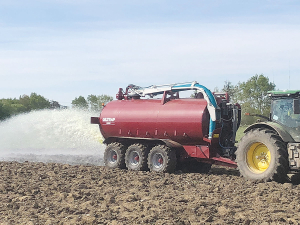Dairy farmers urged to participate in 2026 Levy vote
DairyNZ chair Tracy Brown is urging dairy farmers to participate in the 2026 Levy vote, to be held early next year.
 When making the decision to install or upgrade a farm dairy effluent system it’s important to ask the right questions.
When making the decision to install or upgrade a farm dairy effluent system it’s important to ask the right questions.
Choosing the right effluent system requires professional advice, considering future plans, and picking the right person for the job.
When making the decision to install or upgrade a farm dairy effluent system it’s important to ask the right questions, gather information and take professional advice.
You want the system to work well for many milking seasons to come so it’s important to consider the following:
Planning the right system is important.
One system is the travelling irrigator – the traditional design with a stormwater diversion in place at the yard. The effluent flows from the yard through a stone trap to a storage facility either via gravity feed or pump. It is then irrigated to land using a travelling irrigator. It’s best suited for farms with no landscape/ climate/ soil risk factors, freely drained soils, flat to gently sloping ground, moderate labour input and also for regular shaped paddocks.
Another system is the low-rate sprinkler with mechanical separation.
This system has a storm water diversion at the yard. The effluent then flows through a stone trap to a mechanical separator where the solids are removed. The liquid is then pumped to storage and irrigated to land via a small number of low-rate applicators that are moved frequently.
This is best suited for farms that require flexibility in application depth and rate, such as high-risk soils, high rainfall areas or sensitive catchments, especially suited to poorly drained or artificially drained soils, all slopes and works well in small or irregular paddocks.
The muck spreader system typically includes a storm water diversion then flow through a stone trap to a storage facility. A pump station is required if there is no gravity to storage. Effluent is stirred and sucked from storage into a muck spreader truck and sprayed to land.
This is best suited for smaller farms and lower cow numbers, or when applying effluent to remote areas, all types of soils and flat to sloping land.
Article by DairyNZ
With the current situation in the European farm machinery market being described as difficult at best, it’s perhaps no surprise that the upcoming AgriSIMA 2026 agricultural machinery exhibition, scheduled for February 2026 at Paris-Nord Villepinte, has been cancelled.
The Meat Industry Association of New Zealand (MIA) has launched the first in-market activation of the refreshed Taste Pure Nature country-of-origin brand with an exclusive pop-up restaurant experience in Shanghai.
Jayna Wadsworth, daughter of the late New Zealand wicketkeeper Ken Wadsworth, has launched an auction of cricket memorabilia to raise funds for I Am Hope's youth mental health work.
As we move into the 2025/26 growing season, the Tractor and Machinery Association (TAMA) reports that the third quarter results for the year to date is showing that the stagnated tractor market of the last 18 months is showing signs of recovery.
DairyNZ chair Tracy Brown is urging dairy farmers to participate in the 2026 Levy vote, to be held early next year.
Beef + Lamb New Zealand (B+LNZ) is calling for nominations for director roles in the Eastern North Island and Southern South Island electoral districts.